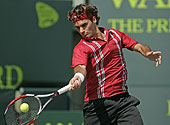Upon reviewing the source material,
Play Better Tennis in 2 Hours, I find myself unsure of what is actually being said or propounded as a teaching/learning tool.
The quote appears in Chapter 7, entitled "How to Return a Hard Ball". That chapter is very short, extending from pages 149-153. There are only two references to hitting beneath the sweetspot, with almost no elaboration elsewhere in the chapter or book. There is an italicized side bar that states "Hitting the ball off center helps keep the racquet closed". Then, in the text on page 150 is this small paragraph:
"The other critical factor in returning a hard ball is not to meet the
ball head on. Deflect it with the lower part of the strings. Just as
in martial arts, you turn your opponent's force around and send it
back in the direction it came from."
There is an interesting two-volume set of tennis instruction/coaching techniques published by the German Tennis Association entitled, simply,
Tennis Course. Originally published in 1995, this was made available in English by Barron's in 2000. Volume 1 deals with "Techniques and Tactics". Pages 43-44 concern the ball's contact with the racquet face and ensuing trajectory. Two scenarios are presented: (1) the racquet strikes the ball directly on center, transferring energy to the ball with no spin, and (2) the racquet strikes the ball off center, creating spin. Hardly earth shattering, this is just a fundamental description of how the racquet imparts spin to the ball. What strikes me however, is that traditional tennis instruction speaks, understandably, in terms of the racquet striking the ball, whereas Oscar Wegner, at least in this particular instance, is placing emphasis on the ball striking the racquet.
I'm wondering whether the author is simply advocating the application of topspin to a hard hit return by the opponent, only using what appears to be a very backward explanation? After all, using topspin to control a hard hit ball is a better percentage play than trying to return it flat. And dealing with hard hit balls is the subject of the chapter.
Is this mostly a communicaton issue, because the chapter is not especially well written, and English does not appear to be the author's native tongue? Or is Mr. Wegner actually advocating using a particular part of the stringbed to strike the ball and recommending that players attempt this? 5263, as an MTM instructor, perhaps you could clarify this or offer some insight?
I seem to recall that Vic Braden did some research years ago and found that most players, including pros, did not make contact normally on the center of the sweetspot, but tended to go a bit north or south of there (I don't recollect which). It was along the lines of common myths that Vic was fond of busting with his excellent use of high-speed photography. I tried to find the reference, but had no luck. Still, noting what actually occurs in a stroke is a far cry from recommending that someone attempt to consistently strike the ball in a particular area of the sweetspot, let alone the stringbed. But then again, I'm not sure that's what Oscar Wegner is really saying.
FWIW, I'm not necessarily a proponent of MTM. I often make references to the "modern game", but do so only to contrast my classical training and traditional style of play with the more "modern" tendencies to hit groundstrokes from an open stance with excessive topspin. I have Oscar Wegner's book in my library, sitting not too far from several of Vic Braden's works. I have found
Play Better Tennis in 2 Hours to quite helpful on occasion specifically because the author does offer a different explanation and emphasis on some common principles. It sometimes aids understanding greatly to use different words in an explanation or to come at a subject from another point of view. While I don't endorse MTM, I don't seek to diminish it either. I'm open to learning from all sources.
Cheers!






